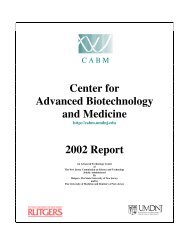Annual Report 2011 - Center for Advanced Biotechnology and ...
Annual Report 2011 - Center for Advanced Biotechnology and ...
Annual Report 2011 - Center for Advanced Biotechnology and ...
Create successful ePaper yourself
Turn your PDF publications into a flip-book with our unique Google optimized e-Paper software.
Human transcription factors are typically complex, multidomain proteins, <strong>and</strong> in<br />
terms of numbers of unique genes represent roughly 10% of the entire human<br />
proteome. Our goal is to express native, folded, individual domains from these<br />
different transcription factors with the hope that optimal specificity <strong>and</strong> affinity may<br />
be obtained by raising affinity capture reagents agains 3D epitopes. In the first year<br />
the Rutgers group has designed single-domain expression constructs using advanced<br />
“domain parsing” software developed by Dr. Janet Huang <strong>and</strong> Prof. Gaetano T.<br />
Montelione (see figure below). Together with Dr. Thomas Acton <strong>and</strong> Prof.<br />
Montelione, we have also developed a new series of high-efficiency E. coli vectors<br />
using “transcript optimized expression-enhancement technology” (“TOEET” – patent<br />
applied <strong>for</strong>). These vectors enable unprecedented levels of expression <strong>and</strong> solubility<br />
to be achieved. In <strong>2011</strong> the group cloned domains from nearly 1400 separate human<br />
transcription factors in >2700 distinct constructs <strong>and</strong> expression-tested approximately<br />
80% of these at small scale. We are now moving on to scale-up <strong>and</strong> production of<br />
multi-milligram quantities of purified antigen <strong>for</strong> our affinity capture reagent partners.<br />
In December, <strong>2011</strong>, we shipped our first batch of purified antigens.<br />
Fig. 1. Example of a portion of the output of the DisMeta server <strong>and</strong> how it can<br />
be used to analyze transcription factor sequences <strong>for</strong> structural in<strong>for</strong>mation.<br />
Shown schematically is a portion of the sequence of a human transiption factor, IF –<br />
16 (γ-interferon-inducible protein 16), analyzed by the DisMeta server.<br />
In this segment of the sequence the server predicts two regions that<br />
appear to have a complex, folded, tertiary structure separated by a<br />
region of polypeptide chain that is predicted to be relatively disordered.<br />
Three-dimentional structures <strong>for</strong> domains represented by the two<br />
ordered regions shown were determined by the NESG. The leftmost<br />
structure (PDB ID 2oq0) is a HIN-200/IF120x domain (InterPro ID<br />
IPR004021), <strong>and</strong> the rightmost structure (PDB ID 3b6y) is a pyrin<br />
domain (InterPro ID IPR004020) (Liao et al, unpulished). This example<br />
illustrates how the DisMeta server can be used to scan TF protein<br />
sequences to find the regions encoding domains that are likely to have<br />
3D epitopes.<br />
41



